
January 16
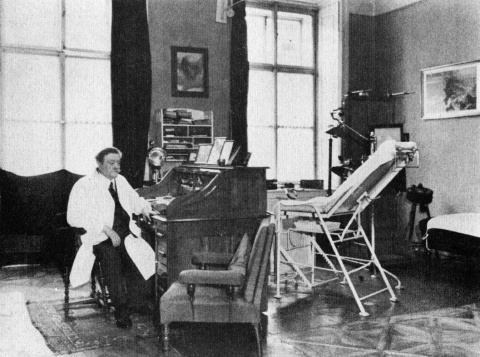
1907 Klara Hitler: Adolf Hitler and his half-sister, Angela Raubal, are called to Dr. Bloch's office, to be informed that Klara Hitler has been diagnosed with an advanced stage of breast cancer, which calls for an immediate operation. When a stricken Adolf asks what his mother's chance of recovery is, Bloch answers, "Only a small one." [For further details, Click here.]
1915 World War I: Alois Schnelldorfer, a new recruit to Gefreiter Adolf Hitler's 16th RIR [List Regiment], writes home:
I was at church in the morning. I wish that you could see something so celebratory some day. The windows are blown out. There was a German sung Mass being held in which about 500-800 men took part. [For further details, Click here.]
1916 World War I: Montenegro capitulates to Austro-Hungarian forces:
After an eight-day offensive that marked the beginning of a new, aggressive strategy in the region, Austro-Hungarian troops under commander in chief Franz Conrad von Hotzendorf take control of the Balkan state of Montenegro. [For further information, click here]

1917 World War I: Zimmermann Telegram: The German Empire sent a diplomatic proposal to Mexico to make war against the United States, which led in part to a U.S. declaration of war.
1919 USA: Prohibition takes effect: The 18th Amendment to the U.S. Constitution, prohibiting the "manufacture, sale, or transportation of intoxicating liquors for beverage purposes," is ratified on this day in 1919 and becomes the law of the land. [For further details, Click here.]
1920 League of Nations: The first meeting of the Council takes place in Paris, but without the participation of the United States.
1934 Holocaust: The League of Nations protests the treatment of Jews in the Saar and Upper Silesia. (THP)
1937 Holocaust: The Gestapo orders all Jewish youth organizations in Germany dissolved. (THP)
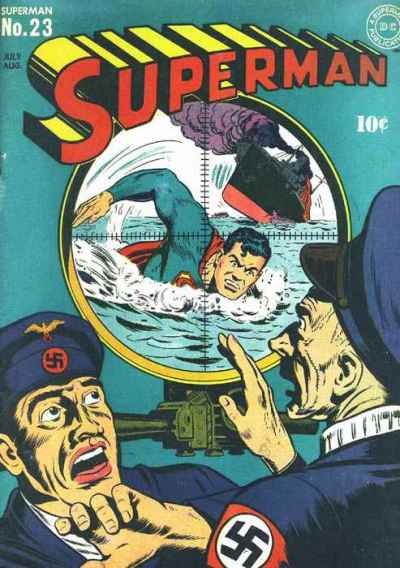
1939 The Superman comic strip—created by American/Jewish teenagers Jerry Seigal and Joe Shuster—appears for the first time.
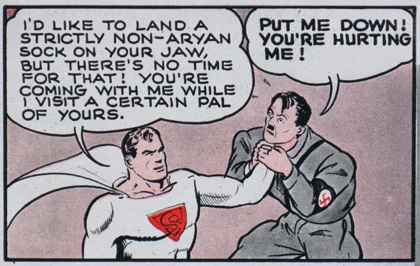
According to most comic book historians, Superman's creation heralded the beginning of the so-called "Golden Age" of comic books, the era during which the visual grammar of the medium was established. It was also a time when many classic characters were created. There was nothing overtly Jewish about the characters created during this era. However, occasionally a comic book character would emerge that had certain Jewish signifiers.
After America became involved in World War Two, Timely Comics superhero Captain America's Jewish creators Joe Simon and Jack Kirby pitted their star-spangled warrior against the Nazi agent Red Skull. Captain America's alter ego Steve Rogers could be seen as a symbol for the way Jews were stereotypically depicted as frail and passive. That is, until he took a serum that transformed him into the robust Captain America. The serum was created by "Professor Reinstein," an obvious nod to famed Jewish physicist Albert Einstein. And Superman gave such a pounding to Nazi agents from 1941-45 that, according to legend, Nazi Minister of Propaganda Joseph Goebbels jumped up in the midst of a Reichstag meeting and denounced the Man of Steel as a Jew. [For further details, Click here.]
1940 World War II: Hitler cancels the German attack in the West until spring, ordering new attack plans to be drawn up.
1941 Church and Reich: From a letter from Bormann to Dr. Posse of the State Picture Gallery in Dresden:

Dear Dr. Posse: Enclosed herewith I am sending you the pictures of the altar from the convent in Hohenfurth near Krumau. The convent and its entire property will be confiscated in the immediate future because of the subversive attitude of its inmates toward the State. It would be up to you to decide whether the pictures are to remain in the convent at Hohenfurth or are to be transferred to the museum at Linz after its completion. I shall await your opinion in the matter. Bormann.
1942 World War II: Various: Carole Lombard
Donald Nelson is appointed head of the new US War Production Board.
1943 World War II: Various: Stalingrad: Pitomnik airfield is overrun:
From 15 January, Pitomnik came under artillery fire of the Red Army and two days later, the airfield was captured, leaving the 6th Army with Gumrak as its only supply airfield. Karpovka had already fallen on 13 January and alongside Pitomnik, four other airfields fell on 17 January. Gumrak eventually fell on 23 January, leaving the 6th Army without any means of direct support. [For further details, Click here.]
The Soviets reverse the citizenship rights of Poles still held in USSR, claiming that Poles betrayed them when Anders led his army out of USSR.
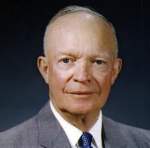
1944 World War II: General Dwight D. Eisenhower takes command of the Allied Invasion Force in London.
1945 Hitler descends into his bunker:

On this day, Adolf Hitler takes to his underground bunker, where he remains for 105 days until he commits suicide.
Hitler retired to his bunker after deciding to remain in Berlin for the last great siege of the war. Fifty-five feet under the chancellery (Hitler's headquarters as chancellor), the shelter contained 18 small rooms and was fully self-sufficient, with its own water and electrical supply. He left only rarely (once to decorate a squadron of Hitler Youth) and spent most of his time micromanaging what was left of German defenses and entertaining Nazi colleagues like Hermann Goering, Heinrich Himmler, and Joachim von Ribbentrop. Constantly at his side during this time were his companion, Eva Braun, and his Alsatian, Blondi. [For further details, Click here.]
From The Arms of Krupp by William Manchester:Retreating from the Wolfsschanze, Hitler returned to the Reich Chancellery in Berlin, that enormous palace of marble, feldspar, red stone, massive doors, and baroque candelabra which he himself had designed and which, second only to Villa Huegal (the Krupp ancestral home), was the most hideous building in Germany. Each day it became less habitable. Allied raids were reducing it to a gutted skeleton. Fifty feet beneath the garden of the old chancellery, however, a shelter had been built. Approached from within the chancellery by stairs leading down to the butler's pantry, the suite comprised twelve rooms, none larger than a closet, and a curved stair descending to an even deeper (though equally cramped) second chamber. This was the Fuehrerbunker, 'the stage,' in the words of H.R. Trevor-Roper, 'on which the last act of the Nazi melodrama was played out.' [See: The Last Days of the Third Reich.]
Ardennes: Patton's Third Army joins up with Courtney Hodges' First US Army, bringing the Ardennes Counter-offensive (The Battle of the Bulge) to an end, together with the last of Germany's offense capability.
Holocaust: Shortly after the last slave laborers are evacuated from Czestochowa, Soviet troops enter the city. (THP)
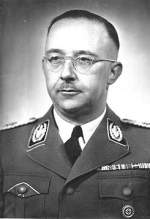
Holocaust: Himmler pardons 2nd Lieutenant Max Taeubner for unauthorized execution of Jews in Russia and grants him fourteen days of leave before returning to the front.
1. The accused shall not be punished because of the actions against the Jews as such. The Jews have to be exterminated and none of the Jews that were killed is any great loss. Although the accused should have recognized that the extermination of the Jews was the duty of Kommandos which were set up especially for this purpose, he should be excused for considering himself to have the authority to take part in the extermination of Jewry himself. Real hatred of the Jews was the driving motivation for the accused . . . .
2. By taking photographs of the incidents or having photographs taken, by having these developed in photographic shops and showing them to his wife and friends, the accused is guilty of disobedience. Such pictures could pose the gravest risks to the security of the Reich if they fell into the wrong hands. [For further details, Click here.]
1946 Nuremberg Tribunal: Day 35:
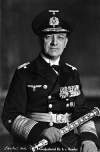
Continuation of the Case against Erich Raeder.

Presentation of the Case against Martin Bormann.
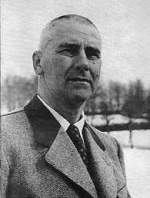
Presentation of the Case against Wilhelm Frick.
Dr. Freidrch Bergold (Counsel for Defendant Bormann):The member of the Prosecution has just submitted a number of documents, in which he proves that, on the suggestion of Bormann, members of the Christian religion were to be excluded from the Party or from certain organizations. I beg the High Tribunal to allow the member of the Prosecution to explain to me how and why this activity, that is, the exclusion of Christians from the Party, can be a War Crime. I cannot gather this evidence from the trial brief. The Party is described as criminal, as a conspiracy. Is it a crime to exclude certain people from membership in a criminal conspiracy? Is that considered a crime? How and why is the exclusion of certain members from the Party a crime? [For all of today's testimony, Click here.]

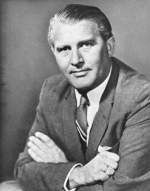
1947 Wernher von Braun: Because of the Top Secret nature of his work . . . Hitler's former lead rocket scientist who is now working for the US Government, had been kept in obscurity in Nazi Germany. On this day, he speaks in public for the first time in fifteen years, in an address to the El Paso Rotary Club. Since he is restricted from revealing anything about his present work for the Army, he speaks on the topic: Future Developments of the Rocket. Von Braun recommends that the following equipment be developed and built:
1. An enlarged V-2 as a "space ship."
2. A three-stage rocket able to lift an artificial satellite into orbit.
3. A winged rocket that could re-enter the atmosphere and land safely.
4. A space station shaped like a wheel to produce artificial gravity as it rotated. This space station would be used as a base for trips to the Moon and planets. (Piszkiewicz) [See: Wunderwaffen: Hitler's Deception and the History of Rocketry.]
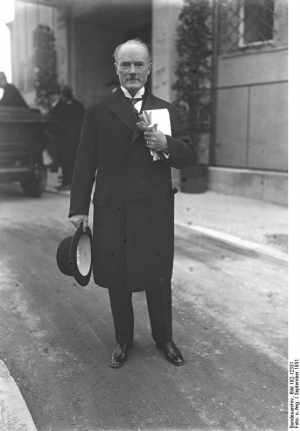
1950 Death: Gustav Krupp von Bohlen und Halbach: German arms tycoon who took his wife's family name in 1906 at the Kaiser's request. Initially cool towards Hitler, he later evolved into a super-Nazi. Krupp was indicted at Nuremberg for exploiting forced laborers, and even though he was obviously guilty, he was declared unable to stand trial because of senility. He died on his estate in Bluehnbach, Austria, on this day.
To have united the purposes of an entire Nation, is the great historical achievement of the man in whose strong hands our President has placed the fate of our people. When Reichschancellor and Fuehrer Adolf Hitler called the General Council of Economy together for the first time on the 20th of September, I had the honor to thank him for the confidence which he had put in the men of the practical business world by calling them to the General Council. I pledged to him unrestrained support. [For further details, Click here.]
1964 Vietnam War: Johnson approves Oplan 34A: Operations to be conducted by South Vietnamese forces supported by the United States to gather intelligence and conduct sabotage to destabilize the North Vietnamese regime. [For further information, click here]
1969 Various:
Vietnam War: Agreement to open peace talks reached: An agreement is reached in Paris for the opening of expanded peace talks. It was agreed that representatives of the United States, South Vietnam, North Vietnam, and the National Liberation Front would sit at a circular table without nameplates, flags or markings. [For further information, click here]
Czechoslovakia: Student Jan Palach sets himself on fire in Wenceslas Square in Prague as a protest against the Soviet invasion of Czechoslovakia the
previous year. [For further information, click here]

1970 Albert Speer writes his friend and archivist, Rudolf 'Rudi' Wolters:
You were quite right (for once!) in what you took out. Frau Irmgard (Clahes) is coming to see me soon and she would certainly have suffered. So I propose that the relevant pages cease to exist. However, contrary to your suggestion, I think they should cease to exist forever. Because a mere postponement to historically more propitious times seems to me a bad idea. For who then could take issue with a distorted interpretation which can only be strengthened by the fact of the pages having been withheld for years. As it stands now, anyone with any sense would consider your deletion of such pages quite legitimate . . . . I hope that, despite the fog that surrounds us here, I am making myself quite clear. (Sereny)
Note: "The Chronik" is a daily record of Albert Speer's activities while a member of Hitler's government. The "drifts" are items that Wolter's altered to spare Speer embarrassment.
1979 Shah flees Iran:

Faced with an army mutiny and violent demonstrations against his rule, Mohammad Reza Shah Pahlavi, the leader of Iran since 1941, is forced to flee the country. Fourteen days later, the Ayatollah Ruhollah Khomeini, the spiritual leader of the Islamic revolution, returned after 15 years of exile and took control of Iran.
In 1941, British and Soviet troops occupied Iran, and the first Pahlavi Shah, who they regarded with suspicion, was forced to abdicate in favor of his son, Mohammad Reza. The new Shah promised to act as a constitutional monarch but often meddled in the elected government's affairs. After a Communist plot against him was thwarted in 1949, he took on even more powers. However, in the early 1950s, the Shah was eclipsed by Mohammad Mosaddeq, a zealous Iranian nationalist who convinced the Parliament to nationalize Britain's extensive oil interests in Iran. Mohammad Reza, who maintained close relations with Britain and the United States, opposed the decision. Nevertheless, he was forced in 1951 to appoint Mosaddeq premier, and two years of tension followed.
In August 1953, Mohammad Reza attempted to dismiss Mosaddeq, but the premier's popular support was so great that the Shah himself was forced out of Iran. A few days later, British and U.S. intelligence agents orchestrated a stunning coup d'etat against Mosaddeq, and the Shah returned to take power as the sole leader of Iran. He repealed Mosaddeq's legislation and became a close Cold War ally of the United States in the Middle East.
In 1963, the Shah launched his "White Revolution," a broad government program that included land reform, infrastructure development, voting rights for women, and the reduction of illiteracy. Although these programs were applauded by many in Iran, Islamic leaders were critical of what they saw as the westernization of Iran. Ruhollah Khomeini, a Shiite cleric, was particularly vocal in his criticism and called for the overthrow of the Shah and the establishment of an Islamic state. In 1964, Khomeini was exiled and settled across the border in Iraq, where he sent radio messages to incite his supporters.
The Shah saw himself foremost as a Persian king and in 1971 held an extravagant celebration of the 2,500th anniversary of the pre-Islamic Persian monarchy. In 1976, he formally replaced the Islamic calendar with a Persian calendar. Religious discontent grew, and the Shah became more repressive, using his brutal secret police force to suppress opposition. This alienated students and intellectuals in Iran, and support for Khomeini grew. Discontent was also rampant in the poor and middle classes, who felt that the economic developments of the White Revolution had only benefited the ruling elite. In 1978, anti-Shah demonstrations broke out in Iran's major cities.
On September 8, 1978, the Shah's security force fired on a large group of demonstrators, killing hundreds and wounding thousands. Two months later, thousands took to the streets of Tehran, rioting and destroying symbols of westernization, such as banks and liquor stores. Khomeini called for the Shah's immediate overthrow, and on December 11 a group of soldiers mutinied and attacked the Shah's security officers. With that, his regime collapsed and the Shah fled.
The Shah traveled to several countries before entering the United States in October 1979 for medical treatment of his cancer. In Tehran, Islamic militants responded on November 4 by storming the U.S. embassy and taking the staff hostage. With the approval of Khomeini, the militants demanded the return of the Shah to Iran to stand trial for his crimes. The United States refused to negotiate, and 52 American hostages were held for 444 days. Mohammad Reza Shah Pahlavi died in Egypt in July 1980. (History.com)
1990 Soviets send troops into Azerbaijan:

In the wake of vicious fighting between Armenian and Azerbaijani forces in Azerbaijan, the Soviet government sends in 11,000 troops to quell the conflict.
The fighting—and the official Soviet reaction to it—was an indication of the increasing ineffectiveness of the central Soviet government in maintaining control in the Soviet republics, and of Soviet leader Mikhail Gorbachev's weakening political power.
Strife in Azerbaijan was the result of centuries of tensions between the Islamic Azerbaijanis and the Christian Armenians. Since the Russian Revolution in 1917, the communist regime managed to maintain relative peace between the two groups, but with the gradual weakening of the Soviet Union during the late-1980s, ethnic rivalries began to re-emerge. In its weakened state, the Soviet Union chose to only partially involve itself in the conflict. The approach was unusual—had it occurred under the strict communist regime of the Cold War's peak, such a tense internal conflict would likely have been immediately and forcefully quelled.
In the latest outbreak of violence, Armenians took the brunt of the attacks and nearly 60 people were killed. Armenian spokesmen condemned the lack of action on the part of the Gorbachev regime and pleaded for military intervention. Soviet officials, however, were not eager to leap into the ethnic fray and attempted to downplay the seriousness of the situation in the press. One Soviet official declared that the fighting in Azerbaijan was not a "civil war," but merely "national strife."
Some Gorbachev supporters even voiced the suspicion that the violence in the region was being stirred up by anti-Gorbachev activists merely to discredit the regime. Gorbachev dispatched 11,000 Soviet troops to quiet the situation, and the United States government supported his action as a humanitarian response to the killings and terror.
The troops Gorbachev sent did little to alleviate the situation—over the next two years, ethnic violence in Azerbaijan continued, and the weakening Soviet regime was unable to bring a lasting resolution to the situation. Less than two years later, Gorbachev resigned from power and the Soviet Union ceased to exist. (History.com)
1991 Gulf War begins:
At midnight in Iraq, the United Nations deadline for the Iraqi withdrawal from Kuwait expires, and the Pentagon prepares to commence offensive operations to forcibly eject Iraq from its five-month occupation of its oil-rich neighbor. At 4:30 p.m. EST, the first fighter aircraft were launched from Saudi Arabia and off U.S. and British aircraft carriers in the Persian Gulf on bombing missions over Iraq. All evening, aircraft from the U.S.-led military coalition pounded targets in and around Baghdad as the world watched the events transpire in television footage transmitted live via satellite from Baghdad and elsewhere. At 7:00 p.m., Operation Desert Storm, the code-name for the massive U.S.-led offensive against Iraq, was formally announced at the White House.
The operation was conducted by an international coalition under the command of U.S. General Norman Schwarzkopf and featured forces from 32 nations, including Britain, Egypt, France, Saudi Arabia, and Kuwait. During the next six weeks, the allied force engaged in a massive air war against Iraq's military and civil infrastructure, and encountered little effective resistance from the Iraqi air force or air defenses. Iraqi ground forces were helpless during this stage of the war, and Iraqi leader Saddam Hussein's only significant retaliatory measure was the launching of SCUD missile attacks against Israel and Saudi Arabia. Saddam hoped that the missile attacks would provoke Israel to enter the conflict, thus dissolving Arab support of the war. At the request of the United States, however, Israel remained out of the war.
On February 24, a massive coalition ground offensive began, and Iraq's outdated and poorly supplied armed forces were rapidly overwhelmed. Kuwait was liberated in less than four days, and a majority of Iraq's armed forces surrendered, retreated into Iraq, or were destroyed. On February 28, President George H.W. Bush declared a cease-fire, and Iraq pledged to honor future coalition and U.N. peace terms. One hundred and twenty-five American soldiers were killed in the Persian Gulf War, with another 21 regarded as missing in action.
On March 20, 2003, a second war between Iraq and a U.S.-led coalition began, this time with the stated U.S. objective of removing Saddam Hussein from power and, ostensibly, finding and destroying the country's weapons of mass destruction. Hussein was captured by a U.S. military unit on December 13, 2003. No weapons of mass destruction were found. Although U.S. President George W. Bush declared an end to major combat operations in Iraq on May 1, 2003, an insurgency has continued an intense guerrilla war in the nation that has resulted in thousands of coalition military, insurgent and civilian deaths. (History.com)
Edited by Levi Bookin (Copy editor) Click to join 3rdReichStudies FAIR USE NOTICE: This site may contain copyrighted material the use of which has not always been specifically authorized by the copyright owner. We are making such material available in our efforts to advance understanding of historical, political, human rights, economic, democracy, scientific, environmental, and social justice issues, etc. We believe this constitutes a 'fair use' of any such copyrighted material as provided for in section 107 of the US Copyright Law. In accordance with Title 17 U.S.C. Section 107, the material on this site is distributed without profit to those who have expressed a prior interest in receiving the included information for research and educational purposes. If you wish to use copyrighted material from this site for purposes of your own that go beyond 'fair use', you must obtain permission from the copyright owner. Please note that the list-owner and the moderators are not responsible for, and do not necessarily approve of, the random ads placed on our pages by our web server. They are, unfortunately, the price one pays for a 'free' website.
levi.bookin@gmail.com







